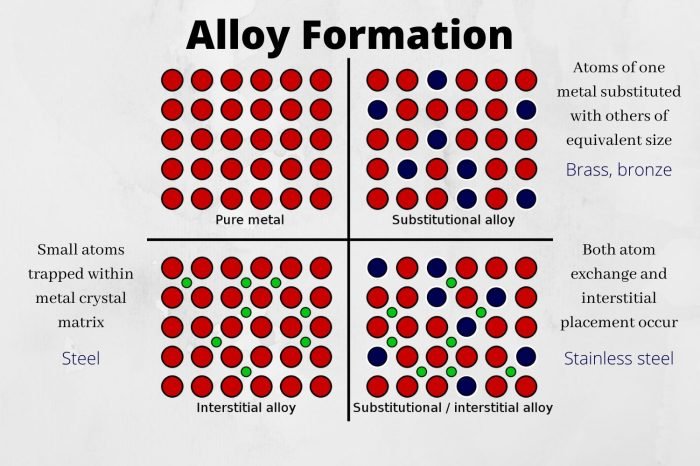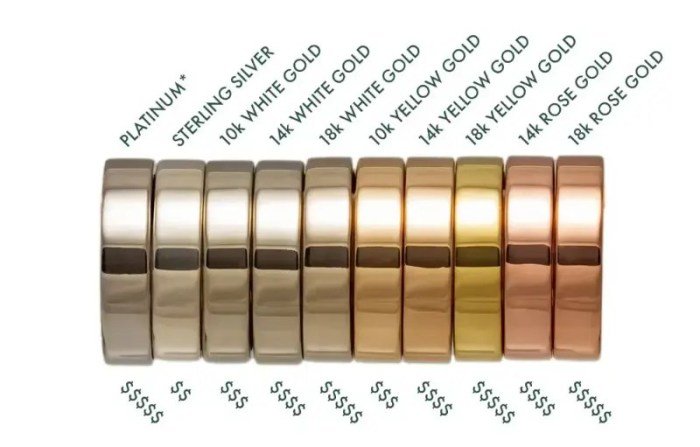Beginning with understanding the different types of metal alloys used in jewelry, the narrative unfolds in a compelling and distinctive manner, drawing readers into a story that promises to be both engaging and uniquely memorable.
Metal alloys play a crucial role in jewelry making, influencing the durability, appearance, and overall quality of the pieces. Exploring the realm of gold, silver, and platinum alloys reveals a fascinating world of craftsmanship and creativity.
Types of Metal Alloys in Jewelry
Metal alloys play a crucial role in the jewelry-making industry, offering a wide range of options for designers and consumers. Let’s explore the most common types of metal alloys used in jewelry and their unique properties.
Obtain a comprehensive document about the application of finding affordable yet high-quality gemstone jewelry that is effective.
One of the most popular metal alloys in jewelry is:
1. Gold Alloys
Gold alloys are created by mixing pure gold with other metals like silver, copper, zinc, and nickel. The properties of gold alloys can vary depending on the metals added, resulting in different karats such as 18K, 14K, and 10K.
- Properties: Gold alloys are valued for their luster, malleability, and resistance to tarnishing. They come in various colors like yellow, white, and rose gold.
- Durability: Higher karat gold alloys are softer and more prone to scratching, while lower karat gold alloys are more durable due to the added metals.
- Appearance: The color and shine of gold alloys can be customized based on the metals added, allowing for a wide range of design possibilities.
2. Silver Alloys
Silver alloys are made by combining pure silver with other metals like copper to improve durability and reduce tarnishing. Sterling silver, for example, consists of 92.5% silver and 7.5% copper.
- Properties: Silver alloys are known for their brightness, affordability, and versatility in design.
- Durability: Silver alloys are softer than gold alloys, making them more prone to scratching and bending.
- Appearance: Silver alloys have a bright white color that can complement a variety of gemstones and designs.
3. Platinum Alloys
Platinum alloys are highly valued for their purity and durability, often used in high-end jewelry pieces. Platinum is often mixed with metals like iridium, palladium, and ruthenium.
- Properties: Platinum alloys are hypoallergenic, resistant to tarnishing, and extremely durable, making them ideal for everyday wear.
- Durability: Platinum alloys are the most durable of all precious metals, with a high resistance to wear and tear.
- Appearance: Platinum alloys have a bright white color that does not fade over time, making them a popular choice for engagement rings and wedding bands.
Gold Alloys: Understanding The Different Types Of Metal Alloys Used In Jewelry

Gold alloys are a popular choice for jewelry making due to their durability, malleability, and timeless appeal. These alloys consist of a combination of gold and other metals, enhancing the properties of the final product.When it comes to gold alloys, the purity of gold is measured in karats. Pure gold is 24 karats, but it is too soft for jewelry making.
Therefore, it is often alloyed with other metals to increase its strength and durability. Commonly used karats for jewelry include 18k, 14k, and 10k, with the number indicating the percentage of pure gold in the alloy.
Composition of Gold Alloys, Understanding the different types of metal alloys used in jewelry
Gold alloys are typically made by mixing pure gold with other metals like silver, copper, and zinc. The choice of metals and their proportions determine the color and properties of the alloy. For example, adding copper to gold creates a rose or pink hue, while mixing silver results in white gold.
Popular Gold Alloys and Characteristics
- 18k Gold: Contains 75% gold and 25% other metals, making it more valuable and less prone to tarnishing compared to lower karats.
- 14k Gold: Comprises 58.3% gold and 41.7% other metals, striking a balance between durability and purity, suitable for everyday wear.
- 10k Gold: With 41.7% gold content, this alloy is the most durable but has a lower gold percentage, making it more affordable.
Silver Alloys
Silver is a popular choice for jewelry making due to its lustrous appearance and affordability. However, pure silver is too soft for most jewelry applications, so it is often alloyed with other metals to increase its strength and durability.
Obtain a comprehensive document about the application of understanding different types of precious and semi-precious gemstones that is effective.
Various Silver Alloys
In jewelry making, silver is commonly alloyed with metals such as copper, zinc, and nickel to create different silver alloys. Some popular silver alloys used in jewelry include:
- Sterling Silver: Consists of 92.5% silver and 7.5% of other metals, usually copper. This alloy is durable and commonly used in fine jewelry.
- Argentium Silver: Contains a higher percentage of silver (93.5% to 96%) and some germanium, making it more tarnish-resistant than traditional sterling silver.
- Mexican Silver: Often mixed with copper and other metals, Mexican silver can vary in purity and is known for its intricate designs.
Silver purity is measured in terms of millesimal fineness, which indicates the parts per thousand of pure silver in the alloy. For example, Sterling Silver has a fineness of 925, representing 92.5% silver content.
Pros and Cons of Different Silver Alloys
- Sterling Silver: Pros include durability, affordability, and a bright luster. However, it can tarnish over time and may cause skin reactions in some individuals.
- Argentium Silver: Known for its tarnish resistance and hypoallergenic properties, Argentium silver is a good choice for those with sensitive skin. However, it can be more expensive than traditional sterling silver.
- Mexican Silver: Offers unique designs and a lower price point compared to other silver alloys. On the downside, the purity of Mexican silver can vary, and it may require more maintenance to prevent tarnishing.
Platinum Alloys
Platinum alloys are highly valued in the jewelry industry for their unique properties and characteristics that make them ideal for creating stunning pieces of jewelry. Platinum alloys are known for their durability, strength, and resistance to tarnish and corrosion, making them a popular choice for high-end jewelry. The metal is also hypoallergenic, making it suitable for those with sensitive skin.
Properties of Platinum Alloys
Platinum alloys are denser and heavier than other metal alloys, giving jewelry pieces a luxurious feel. The metal is also highly malleable, allowing for intricate designs and details to be crafted with ease.
- Platinum-iridium alloys: This combination enhances the durability and hardness of platinum, making it ideal for setting precious gemstones.
- Platinum-cobalt alloys: These alloys offer a white color similar to white gold, but with the added benefits of platinum’s durability and hypoallergenic properties.
- Platinum-ruthenium alloys: This combination provides a bright white color and excellent tarnish resistance, perfect for creating timeless and elegant jewelry pieces.
Concluding Remarks

Dive into the realm of metal alloys in jewelry, where each type tells a unique story of craftsmanship and elegance. Understanding the nuances of gold, silver, and platinum alloys opens up a world of possibilities for creating exquisite pieces that stand the test of time.
Quick FAQs
How is the purity of silver measured in jewelry making?
The purity of silver is measured using a grading system, with sterling silver being the most common type consisting of 92.5% silver and 7.5% other metals.
What makes platinum alloys desirable for jewelry?
Platinum alloys are favored for their durability, hypoallergenic properties, and resistance to tarnishing, making them ideal for crafting high-end jewelry pieces.
What are the different karats of gold and their significance in jewelry making?
Gold purity is measured in karats, with 24k being pure gold. Lower karat gold alloys contain a higher percentage of other metals, adding strength and altering the color of the gold.